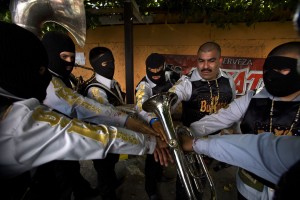Narco Cultura stuns with graphic violence
A documentary about the war on drugs and its influence on Mexican pop culture flooding both sides of the border, Narco Cultura is rife with images of AK-47s, bloodshed, narcotics and the men who push them. The film makes chilling observations about the appropriation of violence into mainstream Mexican music, and questions the image of the glorified and romanticized narco, or Mexican gangster. Is it the new, redefined American dream or nightmare? These are the questions director and cinematographer Shaul Schwarz effectively brings to the table in his gripping documentary Narco Cultura.

Shawl Scwartz newest film Narco Cultura is a gripping documentary about the phenomenon of narco trafficking for the Mexican and Latino population in America.
Schwarz paints a complex image by illustrating different perspectives on the narco world. From the aspiring singer-songwriters who exploit the violence for profit, to the young impressionable Mexican teenagers on either side of the border who praise these icons, Schwarz presents a clear yet complex problem: drug cartels.
Nominated for the Grand Jury Prize at Sundance this year, Narco Cultura juxtaposes images of extreme violence in Juarez, Mexico, with stage performances by the narco corrido singer-songwriters. These artists who pen their lyrics in El Paso and Los Angeles glorify the violence of the Mexican drug culture. The resulting documentary is highly entertaining despite the gut-wrenching material.
The style of the documentary is bold. As it cuts between images of violence to images of narco corrido singers, viewers can’t help but be disturbed. From gutter water turned red with blood swept up by shopkeepers in the streets of Juarez, to the packed crowds singing, “We’re bloodthirsty and we love to kill,” Narco Cultura sheds light on the troublesome images perpetuated by the affection for narcos in Mexican culture.
The structure of the film, like the story it tells, is multi-layered. It unfolds from three different points of view, remaining critical of the culture throughout the film but never judgmental. Schwarz attempts to understand the appeal of such violence, and he succeeds.
The first person introduced is Richi Soto. A crime scene investigator working for SEMEFO, the forensics institute in Mexico, Soto paints a bleak portrait of the benefits of his job. Soto explains that in 2010 alone, there were 3,622 murders in Juarez. During his daily routine, Soto investigates about 10 murders. Effectively illustrated by the images of rows of bullet shells ready for investigation, a very small percentage of these cases ever leads to a resolution. The sheer volume of murders is simply unmanageable for the department.
Schwarz then shifts gears to Los Angeles and introduces Edgar Quintero, an aspiring singer who writes corridos for cash. Edgar paints a very different perspective of Mexico and the gangster figure. In his rhyming and foot-tapping corridos, the gangster becomes a hero, a symbol of a life that differs from the oppressed environment most poverty-stricken people experience in Mexico. While fans of the music defend the narco as just another antihero, the film takes a different stance. According to Schwarz, the narco figure is problematic and insensitive to the violence in Mexico. The filmmaker makes this point of view clear by cutting from a scene of Edgar and his fellow singers belting out the lyrics, “with my Ak-47 … we’re bloodthirsty and we like to kill,” to images of a decapitated man.
While Schwarz’s point of view remains highly critical of the narco culture, he goes to great lengths to provide the audience with the opposing perspective, ultimately strengthening his argument. He takes the audience to Culiacan, the largest city in Sinaloa, Mexico, and the base of the largest Mexican cartel. In Culiacan, the audience is taken through streets covered by elaborate tomb sites for narcos. Many of them cost tens of thousands of dollars, complete with detailed inscriptions and construction out of bulletproof materials. The ornate gravestones are the ideal symbol of manhood, and fearlessness, even of the law, one man interviewed in the scene said.
Schwarz then intelligently reinforces his stance on narco culture by eliciting the fact that Edgar hasn’t even visited Mexico. He sings about violence, yet he’s never even witnessed the gangster lifestyle.
In defense of this appropriation of violence, the narcos compare their work to the American gangsta rap movement of the ’90s. The difference, and flaw, in their argument is that gangsta rap deals primarily with the songwriters’ personal experiences and hustle in the ghetto. By contrast, Edgar, and a lot of other corrido artists in the United States, haven’t even been to Mexico. Edgar explains that the corridos in Los Angeles get inspiration by logging on to narco blogs, where cartel members post videos of violent interrogations and murders.
Although already a comprehensive and multidimensional presentation of the narco culture, Schwarz adds the point of view of the Mexican youth. In one scene, a young Mexican high school student blushes as she happily explains her longing for a narco boyfriend. The scene presents the most disturbing element of the entire film — the inability of youth to distinguish moral from immoral.
From start to finish, the images in Schwarz’s documentary are far from easy to digest. The graphic violence, however, is justified. The romanticism and glorification of the gangsters of the narco culture juxtaposed with the real life violence is what make Schwarz’s documentary effective. Undeniably profound and entertaining despite it’s nightmarish implications, Narco Cultura is a worthwhile cinematic experience.
